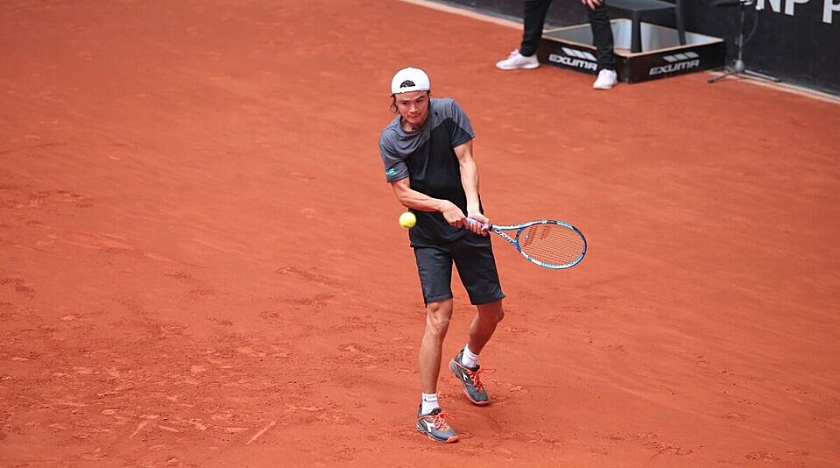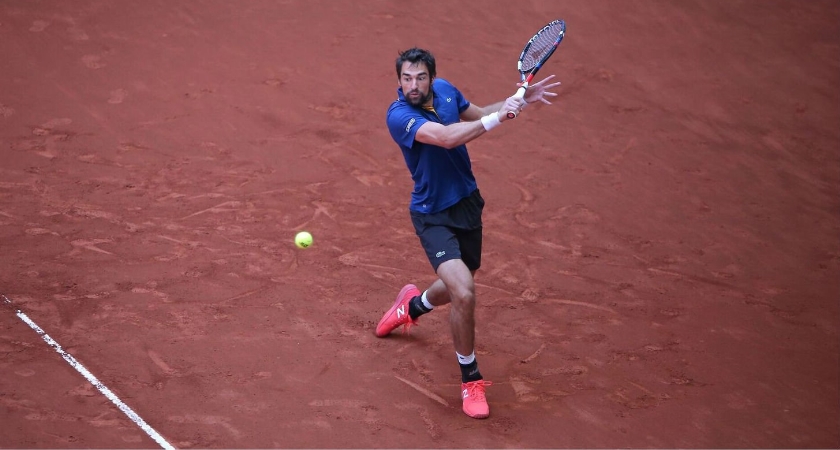Taro Daniel def. Rogerio Dutra Silva 1-6 6-1 6-4
Players often claim that playing in a crowded stadium motivates them to play better. Well, the ones at the Istanbul Open this week do not have that luxury. Matches are being played in front of empty stands, and I mean, literally. Discussing the reasons for the tragic state of (non-)attendance at the Istanbul Open would require dozens of pages and an afternoon panel, but that topic would go beyond the intended scope of this match-recap post. For those interested, I have extensively written about it in my past Istanbul Open articles on this site (see Istanbul Open 2015 and 2017 related ones).
My point in mentioning the empty stands is rather related to the two players that walked on the court to play the first quarterfinal match of the day in this year’s edition of the tournament. Their names are Rogerio Dutra Silva and Taro Daniel. The former is on his fourteenth year on the tour and the latter, on his eight. They are both ranked outside the top 100 – 104 and 114 respectively – and they have never gotten to the semifinal round of an ATP event. Much of their success has come on the Challenger tour. With a career opportunity presented to them as they stepped on the court earlier today, I would guess that neither needed the stands filled for extra motivation.
Dutra Silva began the match as most people who have seen him play many times would have expected him to begin. Get engaged in tedious, long baseline rallies, move around the backhand as much as possible to hit forehands, and keep the ball deep and high with plenty of topspin. In simpler terms, get a lot of balls back and outlast the opponent. It’s a simple formula, made famous by the Swedish players during the 1980s (except the running around the backhand). It also happens to be the only one that Dutra Silva has regularly utilized – and has at his disposition, to be frank – in his 14 years as a professional. The Brazilian is your emblematic clay-court grinder.
Daniel, for his part, is a baseliner too, but can generate more pace from the baseline and on his first serve. You may remember him from his upset win over an out-of-form Novak Djokovic in Indian Wells this year or from his four-set loss to Rafael Nadal at the US Open last year. Although a baseliner himself, he can flatten out and hit winners on both wings, but he can also be erratic. One thing he certainly did not need to do was to get into long rallies against the veteran Dutra Silva from behind the baseline.
Yet, that is precisely what occurred in the first set. A pattern, very convenient to the 34-year-old Brazilian, began to emerge. Daniel got involved in mid-pace rallies from behind the baseline and perhaps waited “too patiently” to get that one opportunity to strike the “higher” percentage winner. As a result, Dutra Silva got to play plenty of above-8-shot rallies and had time to calibrate his strokes. Daniel grew frustrated and committed more errors, eventually bringin the first set to an abrupt close, 6-1 in favor of Dutra Silva.
It was clear that Daniel needed to get away from his opponent’s strengths and take risks. He did, it worked, and the match turned around. It was that simple, that straight-forward.
Taro did what any player should do against a consistent opponent who likes to use his forehands to control the baseline. Since Dutra Silva was parked on the ad corner to allow room for his forehands, Daniel began accelerating down-the-line with his backhand to catch him off-guard. This allowed Taro to create space and hit winners to the open court, or at least, force Dutra Silva to hit more backhands, his weaker side by far. Once Daniel got ahead by a break early in the second, he became confident and began producing some spectacular winners. The second set also ended 6-1, this time in Daniel’s favor.

Third set started with another reversal, as Daniel turned erratic once again and Dutra Silva raced to a 4-0 lead. He looked poised to grab the 5-0 lead when he hit a fine drop-volley winner to get the 40-30 lead. Then, arrived the most critical three-point sequence of the match.
Dutra Silva committed, out of nowhere, a routine forehand cross-court error from the baseline at 40-30. At deuce, he hit a backhand that landed on the service line. Daniel stepped in and approached the net on a hard shot to Dutra Silva’s forehand. The Brazilian missed the makeable passing shot wide. In the ensuing break point, Dutra Silva approached the net and missed a backhand volley, wide again. Ironically, all three errors landed almost on the same spot, wide in the deuce-side doubles alley.
It would only get worse for Dutra Silva. Leading 4-2, and serving at 30-30, he had a sitter inside the baseline. He lined up his forehand and nailed it. The ball landed almost exactly to the same wide spot in the doubles alley as the three errors previously noted. He lost the next point and his service game. The reset button was hit after Daniel easily held serve in the next game and the scoreboard showed 4-4 in the final set.
In that ninth game, Dutra Silva was clearly not content with just rallying. He started off with a swing-volley winner at the net and did not let up. He recorded two more forehand winners, but this tactical shift also led to errors. It was obviously not his A plan but Daniel was feeling pumped at that juncture in the match and Dutra Silva probably felt like he needed to take more charge in the rallies. His backhand down-the-line error on game point at 40-30 proved fatal. Daniel won the next two points to break Rogerio’s serve one more time and served for the match at 5-4.
Dutra Silva appeared mentally deflated during the game change and as he walked out to play the tenth game. Daniel quickly raced out to a 40-0 lead. He put Dutra Silva away on his second match point, completing an impressive come back in the final set, winning the last six games in succession.
Kudos to Daniel for the 1-6 6-1 6-4 win, but you also cannot help but feel bad for Dutra Silva. At 34 years of age, he may have seen his last genuine shot at reaching the semifinal stage of an ATP event. He played a younger, less-experienced, lower-ranked opponent on his favorite surface and had a substantial lead to put the match in the books. He had his foot in the door but could not enter. The good news for him, the clay-court season has only begun. As for Daniel, his dream week carries on.
Jérémy Chardy def. Thomas Fabbiano 6-2 6-2
There is not much to write about this particular match. Chardy was the more accomplished player and the clear favorite to advance to the semifinal. The scenario played out as expected, with zero deviation.

Something extraordinary needed to happen for Fabbiano to have a chance. Any glimmer of hope for that possibility quickly eroded when the 100th-ranked Italian committed two unforced errors in a row to lose his first service game of the match. Both were on routine forehands struck from the middle of the court, the first one landing in the net, the second sailing wide.
Following the break, the encounter turned into a routine Chardy match, meaning the Frenchman dictated rallies with his forehand, occasionally collecting free points with his first serve. Fabbiano resorting to slice backhands when he was chasing balls further helped Chardy’s cause as it gave him time to run around the backhand to unload his forehands. He finished the set by breaking his opponent’s serve one more time.
The first set’s pattern was almost identically repeated in the second, with Chardy earning the break on the fourth game. Fabbiano could never manage to find a solution to Chardy’s dominance from the baseline. The 87th-ranked Frenchman recorded the 6-2 6-2 win in one hour and seventeen minutes. He should once again be the clear favorite when he faces Daniel tomorrow in the semifinals.
Unfortunately, I will be unable to recap the last two quarterfinal matches of today.
Until tomorrow, for the semifinals.
